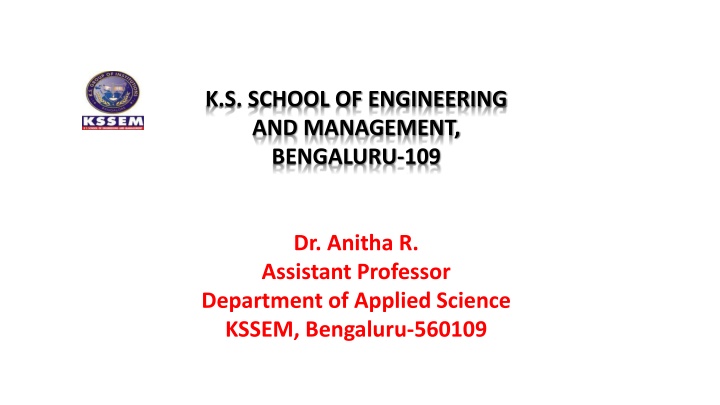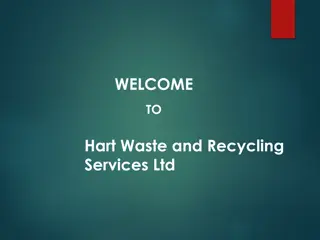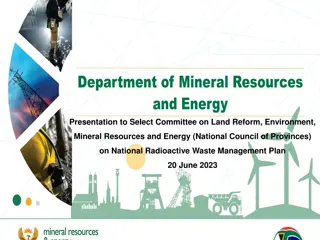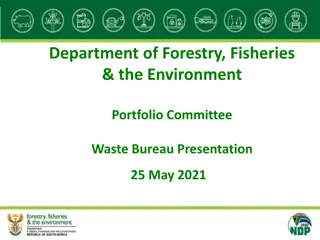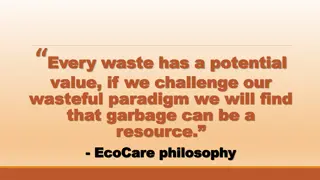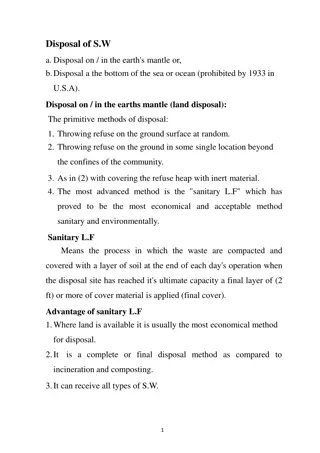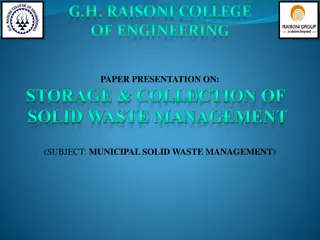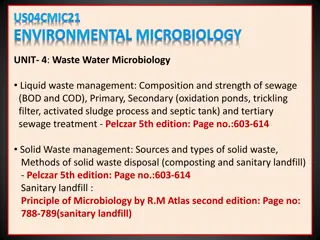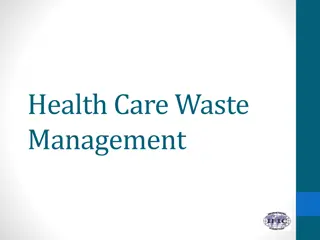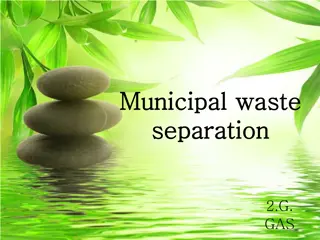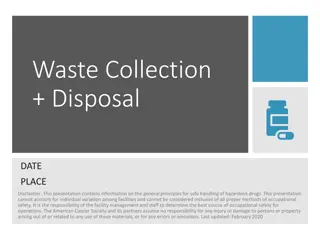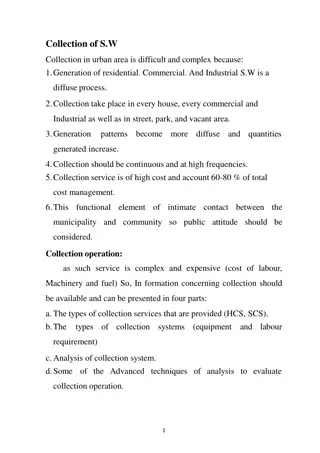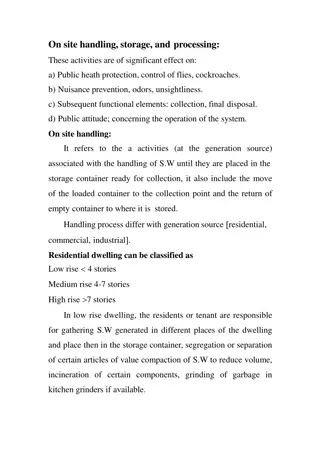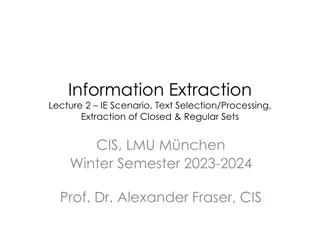E-waste Composition and Extraction Methods
Electronic waste (e-waste) is a complex mixture of materials including metals, plastics, glass, circuit boards, batteries, and hazardous substances. The characteristics of e-waste highlight its hazardousness, global impact, resource depletion, and environmental implications. Hydrometallurgical and pyrometallurgical methods are used for extracting valuable materials from e-waste, with hydrometallurgical extraction being a more environmentally friendly option.
Download Presentation

Please find below an Image/Link to download the presentation.
The content on the website is provided AS IS for your information and personal use only. It may not be sold, licensed, or shared on other websites without obtaining consent from the author.If you encounter any issues during the download, it is possible that the publisher has removed the file from their server.
You are allowed to download the files provided on this website for personal or commercial use, subject to the condition that they are used lawfully. All files are the property of their respective owners.
The content on the website is provided AS IS for your information and personal use only. It may not be sold, licensed, or shared on other websites without obtaining consent from the author.
E N D
Presentation Transcript
K.S. SCHOOL OF ENGINEERING AND MANAGEMENT, BENGALURU-109 Dr. Anitha R. Assistant Professor Department of Applied Science KSSEM, Bengaluru-560109
Composition of E-waste: The composition of electronic waste (e-waste) can vary depending on the type of device and its components. In general, e-waste contains a mixture of materials including: 1. Metals: E-waste often contains valuable metals such as copper, gold, silver, and aluminium. 2. Plastics: Many electronic devices contain plastic components, including casings, insulation, and cables. 3. Glass: Electronic devices often contain glass components, such as screens and lenses. 4. Circuit boards: Many electronic devices contain circuit boards, which contain a mixture of metals and other materials. 5. Batteries: Some electronic devices contain batteries, which can contain hazardous materials such as lead, mercury, and cadmium. 6. Other hazardous materials: E-waste may also contain other hazardous materials, such as flame retardants, heavy metals, and polychlorinated biphenyls (PCBs).
Characteristics of E-waste: The characteristics of electronic waste (e-waste) can include: 1. Complexity: E-waste often contains a complex mixture of materials, making it challenging to recycle and dispose of properly. 2. Hazardousness: E-waste can contain hazardous materials such as heavy metals, flame retardants, and batteries, which can pose significant environmental and health risks. 3. Volatility: E-waste is a rapidly growing waste stream due to the increasing use of electronic devices and the limited lifespan of many electronic products. 4. Global issue: E-waste is a global issue, as electronic devices are Manufactured, used, and discarded worldwide. 5. Resource depletion: The extraction of raw materials for electronic devices contributes to resource depletion, and the improper disposal of e- waste can lead to environmental contamination and waste of valuable resources. 6. Environmental and health impacts: Improper disposal of e-waste can lead to significant environmental and health impacts, including soil and water contamination, air pollution, and harm to human health.
Hydrometallurgical extraction of E waste: E-waste hydrometallurgical extraction is a process used to extract valuable metals and other materials from electronic waste through chemical reactions in aqueous solutions. The process typically involves the following steps: 1. Pre-treatment: This involves the fragmentation and size reduction of electronic waste to prepare it for further processing. 2. Leaching: The e-waste is treated with chemical reagents in a solution to dissolve the metals and other materials, creating a leachate. 3. Separation: The leachate is then processed to separate and purify the metals and other materials, through methods such as precipitation or ion exchange. 4. Recovery: The extracted metals and other materials are then recovered and processed for reuse. Hydrometallurgical extraction is a more environmentally friendly alternative to thermal treatments, as it generates less hazardous waste and can be more easily regulated to minimize environmental impact.
Pyrometallurgical methods E-waste recycling: E-waste pyrometallurgical methods refer to the process of extracting valuable metals and other materials from electronic waste using high temperatures. These methods include: 1. Smelting: The e-waste is melted in a furnace and then separated into individual metals and other materials. 2. Refining: The metals from the smelted e-waste are further processed to remove impurities and improve their quality. 3. Incineration: Electronic waste is burned at high temperatures to reduce its volume and recover metals. Pyrometallurgical methods are effective at recovering valuable metals from e- waste, but they also generate hazardous byproducts and require significant energy inputs. Additionally, these methods can pose a risk to the environment and human health if not properly regulated and monitored.
Direct recycling of e waste: Direct recycling of e-waste refers to the process of recovering valuable materials from electronic waste without the need for intermediate processing steps. This can include processes such as shredding, granulating, and sorting, which are used to separate the different components of e-waste, such as metals, plastics, and glass. The separated materials are then processed to extract the valuable components and prepare them for reuse. Advantages of direct recycling: Several advantages over other methods of e-waste recycling, including lower energy inputs, lower environmental impact, and the potential for higher quality end products. By combining direct recycling with other methods, such as chemical and pyrometallurgical processing, it is possible to maximize the recovery of valuable materials from electronic waste and minimize the environmental impact of e- waste management.
Role of stakeholders in the environmental management of e-waste: Who are called stakeholders a local and global perspective: The role of stakeholders in the environmental management of e-waste can vary depending on the stakeholder and their level of involvement. From a local perspective, stakeholders in the environmental management of e- waste may include: Governments: responsible for creating and enforcing regulations and policies to manage e-waste, as well as promoting public awareness and education about e-waste management. Manufacturers: responsible for the design, production, and disposal of electronic products, and may be involved in the collection and recycling of e-waste. Consumers: responsible for properly disposing of e-waste and making informed choices about the purchase of electronic products. E-waste recyclers and processors: responsible for the safe and responsible management of e-waste, including the collection, dismantling, and recycling of electronic waste. Environmental organizations: responsible for advocating for sustainable and responsible e-waste management practices and raising public awareness about e-waste issues. Community groups: responsible for organizing and participating in e- waste recycling programs and events and promoting awareness of e-waste issues in the local community.
From a global perspective, stakeholders in the environmental management of e-waste may include: International organizations: such as the United Nations, World Trade Organization, and the International Telecommunication Union, that are responsible for setting global standards for e-waste management and promoting cooperation and collaboration among countries. Transnational corporations: responsible for the design, production, and distribution of electronic products on a global scale, and have a significant impact on e-waste management practices. Global e-waste trade networks: responsible for the transportation and processing of e-waste between countries and may impact the environmental and health outcomes of e-waste management. Governments of developed and developing countries: responsible for creating and enforcing regulations and policies to manage e-waste, as well as promoting public awareness and education about e-waste management. Environmental organizations: responsible for advocating for sustainable and responsible e-waste management practices and raising public awareness about e-waste issues on a global scale. International community: including consumers, NGOs, and civil society organizations, that can raise awareness about e-waste issues, demand responsible e-waste management practices, and push for change at the international level.
NPTEL link: https://youtu.be/_r5rHyMHKEg?si=0mUxmXCAy1jHLBCi https://youtu.be/kUCVBhSka2Q?si=H9aoy5T6LnyfwUWT YouTube link: https://youtu.be/ur0MdW5rTIc?si=7l146G1J4URE0ts8 https://youtu.be/U3KUJTDPsSE?si=Y-FnH5Ym8AFaVTTe
